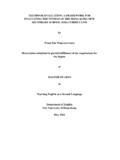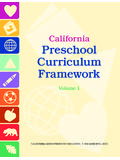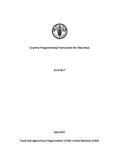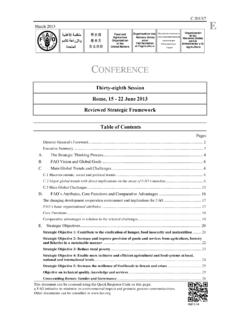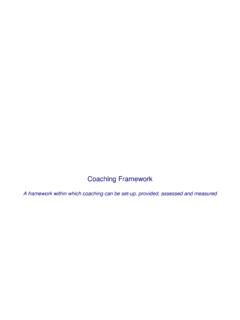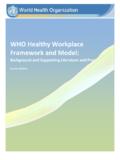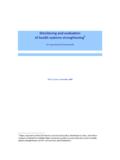Transcription of IASB issues the Conceptual Framework exposure …
1 Applying IFRSC onceptual FrameworkIASB issues the Conceptual Framework exposure draftJune 20151 June 2015 Applying IFRS IASB issues the Conceptual Framework exposure draftContents What you need to know The IASB has proposed revisions to its Conceptual Framework . The purpose of this project is to provide the IASB with an updated andmore complete set of concepts to use for standard-setting, guidance forpreparers in developing accounting policies, and assistance to others intheir efforts to understand and interpret the standards. The proposed changes to the Conceptual Framework may impact theapplication of IFRS in situations where no standard applies to a particulartransaction or event, or when a standard allows a choice of accountingpolicy. The comment period ends 26 October of the proposals2 Objective of GPFR and qualitative characteristics of usefulfinancial information.
2 2 Reporting entities .. 3 Elements of financial statements .. 3 Recognition and derecognition .. 4 Measurement .. 5 Presentation and disclosure .. 5 Transitionand effective date .. 6 Next steps6 June 2015 Applying IFRS IASB issues the Conceptual Framework exposure draft2 OverviewThe International Accounting Standards Board (the IASB or the Board)issued exposure Draft (ED) ED/2015/3 Conceptual Framework for FinancialReporting on 28 May 2015, which proposes comprehensive changes to itsConceptual Framework . The ED proposes revisions to the definitions ofelements in the financial statements, includes guidance on derecognition,discussions on measurement bases, principles for including items in othercomprehensive income (OCI) in relation to performance reporting, andincludes high-level concepts for presentation and existing Conceptual Framework was criticised for its lack of clarity, fornot covering some important concepts and for not being reflective of theIASB s current thinking.
3 Following feedback received on the IASB s agendaconsultation in 2011, the Conceptual Framework project was added to theIASB s work plan in September 2012. Since then, the IASB has issued adiscussion paper (DP)A Review of the Conceptual Framework for FinancialReporting in July 2013. The Board aims to complete the revisions to theConceptual Framework in topics covered in the ED are: Objective of general purpose financial reporting (GPFR) Qualitative characteristics of useful financial information General purpose financial statements (GPFS) and reporting entities Elements of financial statements Recognition and derecognition Measurement Presentation and disclosure Concepts of capital and capital maintenance1 Summary of the proposalsObjective of GPFR and qualitative characteristics of usefulfinancial informationThe IASB has proposed limited amendments to these sections of the existingConceptual Framework , which were issued in 2010 as part of the IASB s jointproject with the US Financial Accounting Standards Board (FASB).
4 2 One of the amendments relates to the discussion of management sstewardship of an entity s resources. The existing Conceptual Frameworkdoes not use the term stewardship , but, instead, describes what stewardshipencapsulates. The IASB has proposed to include the term stewardshipin order to emphasise the need for information required to assess thestewardship function, as a necessary part of the overall objective of section covers the concepts of capital and capital maintenance, which are carried forwardunchanged from the existing Conceptual Framework , apart from some minor IASB and the US FASB started a joint project to revise their Conceptual Frameworks in 2004 andissued two chapters (describing the objective of GPFR and qualitative characteristics of useful financialinformation) in their respective Conceptual Frameworks in 2015 Applying IFRS IASB issues the Conceptual Framework exposure draftIn the existing Conceptual Framework s section on qualitative characteristicsof useful financial information, the IASB had not included a discussion onprudence, stating that prudence is inconsistent with neutrality.
5 Afterconsidering feedback from constituents, the IASB decided to reinstate theconcept of prudence in the ED. The Board believes that prudence is bestdescribed as caution when making judgements under conditions ofuncertainty, that it has a role to play in financial reporting, and can helpachieve neutrality. The IASB has further clarified that prudence works bothways: assets and liabilities should be neither overstated nor entitiesThe ED describes a reporting entity as an entity that chooses, or is required,to prepare GPFS, and it proposes guidance on how to set the boundary of areporting entity. The Board proposes that the boundary can be determinedby either direct control (which results in unconsolidated or individual financialstatements) or by direct and indirect control (which results in consolidatedfinancial statements).
6 The Board also acknowledges the need for combined financial statements incertain circumstances, but does not discuss in the ED when or how entitiescould or should prepare them, stating a preference to undertake a standardor standards-level project on this subject rather than deal with it in any greatdetailin the Conceptual of financial statementsThe ED proposes to revise the current definitions of assets and liabilities. TheED defines an asset as a present economic resource controlled by the entityas a result of past events .3 The term economic resource focuses on rights(or a bundle of rights) which have the potential to produce economic represents a greater focus on accounting for different rights thatcompose economic resources, which encapsulates the notion of accountingfor both tangible and intangible IASB has retained the concept ofcontrol in the definition, in order to assert that an entity must haveboth theability to direct the use of, and rights to obtain, the benefits from theeconomic proposed definition of a liability - a present obligation of the entity totransfer an economic resource as a result of past events 4- places emphasison an entity s obligation at the reporting date, as a consequence of a pasttransaction or other event that imposed the obligation on the entity.
7 The EDalso contains further guidance on what a present obligation is, which wouldessentially include any obligation arising from past events that an entity hasno practical ability to the definitions of both assets and liabilities, the IASB decided notto retain the notion of an expected inflow or outflow of resources inacknowledgement of concerns about varied interpretations of the term expected and the notion of a threshold level of probability. The Boardbelieves that this is best addressed within the recognition existing Conceptual Framework defines an asset as a resource controlled by the entity as a result ofpast events and from which future economic benefits are expected to flow to the entity .4 The existing definition of liability is a present obligation of the entity arising from past events, thesettlement of which is expected to result in an outflow from the entity of resources embodying economicbenefits.
8 June 2015 Applying IFRS IASB issues the Conceptual Framework exposure draft4 How we see itThe IASB acknowledges in the Basis forconclusionsof the proposedConceptual Framework that the requirements of IAS 37 Provisions,Contingent Liabilities and Contingent Assets as interpreted by IFRIC 21 Levies are inconsistent with the proposed new concepts for identifyingliabilities. However, as the Conceptual Framework does not override therequirements of individual standards or interpretations, and any decision tomake amendments to existing IFRSs would require the IASB to go throughits due process of adding a project to its agenda and development of an ED,entities will have to continue applying the current applicable and derecognitionRecognitionThe recognition criteria in the current Conceptual Framework require thatan item be recognised if it is: a) probable that any future economic benefitassociated with it will flow to or from the entity; and b) it has a cost or valuethat can be measured with reliability.
9 The Board observed that, acrosscurrent standards, the application of the probability criterion is example, in IFRS 9 Financial Instruments, there is no probabilityrecognition criterion, otherwise instruments such as derivatives would not , the IASB proposed that the Conceptual Framework should set outcriteria for recognition based on the qualtiative characteristics of usefulfinancial information. An asset or liability (and any related income, expenseor change in equity) is recognised if: It provides users of financial statements with relevant information aboutthe asset or liability and any resulting income, expense or change in equity It provides a faithful representation of the asset or liability and of anyresulting income, expense or change in equityAnd The benefit of the information provided by recognising the asset orliability outweighs the cost of doing soExistence uncertaintyOne of the challenges of recognition is existence uncertainty.
10 In trying toaddress this issue , the IASB decided to propose listing existence uncertainty ofan asset or liability as one of the indicators that may lead to a conclusion thatrecognition of that asset or liability may not produce relevant information. TheIASB believes that it would not be useful to provide more detailed guidance onhow to address existence uncertainty because the facts are likely to dependvery much on particular we see itAlthough existence uncertainty is dependent on specific facts andcircumstances, it would seem appropriate to address the Conceptual basisat the Conceptual Framework level instead of leaving it to be dealt with atthe standards 2015 Applying IFRS IASB issues the Conceptual Framework exposure draftDerecognitionThe existing Conceptual Framework does not provide guidance onderecognition and, currently, there are inconsistent approaches toderecognition being applied across the standards.










